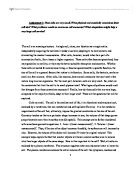However, whilst it is very difficult to define life, a particularly interesting characteristic of life as we know it is that all life feeds on negative entropy; or rather life is something that creates order within its isolated system and passes it on to future generations by reproduction in one form or another. Entropy is a measure of randomness of molecules in a system, and as stated by the Second Law of Thermodynamics, isolated energy systems have a tendency to increase their total entropy until equilibrium is reached. For example a hot object goes from hot to cold not the other way around, or rather an object that is warmer than its surroundings will give off heat to its neighbouring particles, causing them to become more random until they are equally random (equilibrium). Entropy is such an important topic when exploring the question ‘What Is Life?’ and consequently there is a plethora of research devoted to this link between entropy and the evolution of life which began in the early 1900s. In his book named ‘What is Life’, Erwin Schrödinger discussed this relationship and affirmed that a living system lowers its entropy by importing or feeding on ‘negentropy’ (negative entropy) and then stores it. Certainly this appears contrary to the Second Law of Thermodynamics, however, it does not in any way invalidate this law due to that fact that the law applies only in a closed or isolated system in which no form of energy can enter or leave. Therefore in a living organism, which is an open system, entropy can decrease over time. This ability of a living organism to create order in itself, by decreasing its entropy, is what differentiates life from any other form of organized matter.
It is generally agreed upon that the basis of all life is the cell; a structure designed to create order around it. As we know all living organisms exist as unicellular organisms or multicellular organisms and there is a huge range in complexity between organisms varying from the hugely complex and ordered human to the less complex and less ordered amoeba. The cell membrane which exists in all living cells separates the outside from the cytoplasm within the cell, and is essential to hold the organism together. This cell membrane is made up of a fluid mosaic phospholipid bilayer which is partially permeable and thus is not a closed system allowing molecules to enter a cell through channel proteins and other various pathways. Furthermore, every living organism forms from one cell which may or may not divide by mitosis. Once a cell has reached the end of the cell cycle, cell differentiation occurs and each somatic cell takes on a specific role or function. These differentiated cells work as a collective and show complex organized patterns. The existence of this complex and organised internal structure allows the cell to lower its entropy and is thus intrinsic to cellular life.
The ability to capture and harness energy is another fundamental characteristic of all life and all organisms rely on energy from the sun, whether directly or indirectly. Autotrophic organisms harness energy through photosynthesis in which light energy from the sun is converted into useful chemical energy which maintains metabolic processes for survival. Heterotrophic organisms then ingest the autotrophic organisms as a form of energy. This energy is harnessed to create structures within the organism so that order can be created and maintained.
Furthermore, all life grows and develops by rebuilding itself and becoming more complex and more ordered. Another important characteristic shared by all living organisms lies in their response to stimuli and interaction with the external environment. Life can adapt to changes in the environment in three basic ways. In the first way, reversible changes occur, for example increased heart rate in response to a change in altitude. Secondly, somatic changes occur in response to prolonged changes in the environment, for example after a long time at high altitude your heart rate would slow down. This response is also reversible. Finally, non reversible genotypic adaptations occur in which changes are made to the genetic makeup of the life form as a result of mutations, for example the development of resistance to pesticides by insects.
In addition, reproduction is a central characteristic of life. All species of living organisms reproduce, whether sexually or asexually, and consequently pass on their genetic information to their offspring. If we assume that life is something that creates order, and because everything that lives ultimately dies, a living organism can only continue to maintain order by passing it onto future generations via its germ line cells. Essentially life must be inherited from living organisms.
However, at the core of all these characteristics which define life, we find DNA. DNA is regarded as the ‘sin qua non’ of life. DNA is a programme which acts as a set of instructions for all cells. These instructions direct every activity of a life form including the building of proteins, the building blocks of life. Essentially DNA provides information which allows cellular life to create order in a disordered world.
Despite these common features of what we consider ‘living’ there is much debate concerning viruses. Viruses have characteristics of living things, for example nucleic acid and protein coats, however they cannot undergo metabolic processes or replicate independently of a host cell which contains all the necessary apparatus for viral construction. So whether or not we consider viruses as alive depends upon our definition of what life is, and as I have discussed, that is a particularly complex issue.







